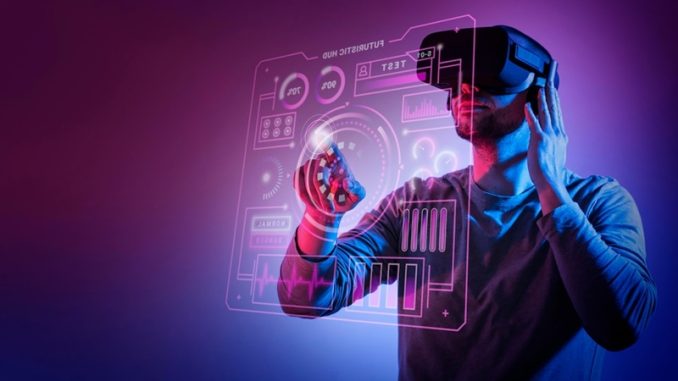
In an era where the boundary between the physical and digital worlds is increasingly blurred, Augmented Reality (AR) emerges as a transformative force. AR technology seamlessly integrates computer-generated elements into our real-world surroundings, redefining entertainment, education, healthcare, and industries like retail and manufacturing. Join us as we journey through the diverse landscape of AR, uncovering its applications, implications, and the exciting future it promises.
What Is Augmented Reality?
Augmented reality (AR) is an innovative technology that smoothly integrates digital information and virtual elements into the real world. Unlike virtual reality, which immerses users entirely in a digital environment, AR enhances the physical world by overlaying computer-generated images, sounds, or information onto a user’s view of the real world.
This fusion of digital and physical creates an immersive and interactive experience, blurring the boundaries between what is real and what is computer-generated. AR can be experienced through various devices, from smartphones and tablets to specialized AR glasses and headsets.
Ar Technology And Components
AR technology relies on a combination of hardware and software components to deliver its immersive experiences. Devices like smartphones and tablets use their cameras, sensors, and processing power to recognize the physical environment and superimpose digital content onto it.
Specialized AR headsets and smart glasses offer more advanced capabilities, often incorporating depth-sensing cameras and spatial mapping technology for precise interactions. AR software platforms and applications enable the creation and deployment of AR experiences, making them accessible to various industries and applications.
Augmented Reality In Everyday Life
Ar In Entertainment And Gaming
Augmented reality has revolutionized the entertainment and gaming industries. AR games like Pokémon GO brought the concept of capturing virtual creatures in the real world to millions of users. Beyond games, AR is enhancing storytelling and immersive experiences in entertainment, with applications in movies, marketing campaigns, and theme park attractions.
Ar In Education And Training
In the realm of education and training, AR is transforming traditional learning methods. By overlaying educational content with physical objects or environments, AR enhances understanding and retention. Students can interact with 3D models historical reconstructions, or even take virtual field trips. In the professional world, AR is used for hands-on training, enabling trainees to practice complex procedures in a safe and controlled digital environment.
Ar In Healthcare And Medicine
Augmented reality is making significant inroads into healthcare and medicine. Surgeons use AR during procedures to visualize patient data, making surgery more precise and efficient. Patients benefit from AR by understanding medical conditions through visualizations. AR-based simulations aid medical students in practising surgeries and treatments. AR glasses also assist in remote consultations, allowing specialists to guide in real-time.
Augmented Reality In Business And Industry
Ar For Retail And Marketing
The retail and marketing sectors leverage AR to enhance customer experiences. AR apps allow consumers to visualize products in their real-world environments before purchasing, reducing uncertainty in online shopping. Retailers use AR for interactive advertising, pop-up stores, and virtual try-ons. Brands engage customers with gamified marketing campaigns, enhancing brand loyalty.
Ar For Manufacturing And Design
Manufacturing and product design benefit from AR’s ability to streamline processes. Engineers and designers use AR for prototyping, visualizing complex structures, and collaborative design reviews. Workers on the factory floor receive real-time instructions through AR glasses, improving productivity and reducing errors. Maintenance technicians use AR for hands-free guidance in equipment repair.
Ar For Remote Assistance
AR is a game-changer in providing remote technical support. Field service technicians can access real-time visual guidance from experts, reducing travel and downtime. Maintenance workers receive step-by-step instructions overlaid on the equipment they’re servicing. This technology minimizes errors and enhances efficiency across various industries, including aviation and energy.
How Does Ar Work On Smartphones, And What Are Its Applications?
AR on smartphones uses the device’s camera and sensors to recognize the environment and overlay digital content. Applications include AR gaming, navigation, interior design visualization, and educational tools.
Can You Explain How Ar Is Being Used In The Healthcare Sector?
In healthcare, AR assists surgeons with visualizing patient data during surgeries, aids medical education through simulations, and enhances patient understanding of medical conditions through visualizations.
What Challenges Does Ar Face In Terms Of Privacy And Security?
AR raises concerns about privacy, as it can capture real-world data. Ensuring secure data handling and preventing unauthorized access to AR devices are paramount for addressing these challenges.
How Can Businesses Implement Ar In Their Marketing Strategies Effectively?
Businesses can implement AR in marketing by creating interactive and engaging experiences, such as virtual try-ons, interactive product demonstrations, and location-based marketing campaigns that entice and engage customers.
Are There Any Emerging Trends In The World Of Augmented Reality?
Emerging trends in AR include the use of AR in remote collaboration and communication, expanded applications in industry-specific training, and the integration of AR with wearable devices like smart glasses.
Conclusion
Augmented reality technology that bridges the physical and digital realms is reshaping our lives in profound ways. Its applications span from entertainment and education to healthcare, manufacturing, and beyond. AR is no longer a concept of the distant future but a transformative force that is already enhancing how we experience and interact with the world. As AR technology continues to advance and find new applications, its potential to revolutionize industries and enrich our daily lives remains boundless.






Leave a Reply